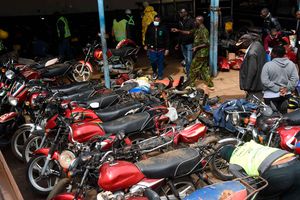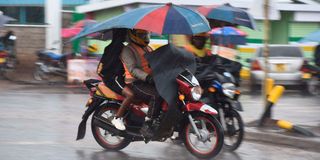
A boda-boda rider ferries a passenger in Eldoret town, Uasin Gishu County.
In one of the wards at Nakuru Teaching and Referral Hospital, James Macharia writhes in agony. His heavily plastered leg flails in the air as he grimaces in pain.
Macharia’s motorcycle collided with a public service vehicle on the Nakuru-Nyahururu highway, flinging him and his passenger nearly 50 feet into the air, according to a close friend. His passenger, a young woman in her early 30s, died instantly.
He had been ferrying her from Mawanga shopping centre to Nakuru City’s Central Business District when the crash happened. Macharia broke his leg but he is lucky to be alive.
Not far from his ward, Patrick Mutai has been in the Intensive Care Unit for a week. He was involved in a separate crash that nearly broke his spine and left him severely maimed. The boda boda rider who was transporting him to Salgaa town died on the spot.
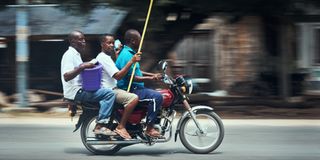
An overloaded bodaboda.
Macharia and Mutai’s cases reflect a growing crisis, one that paints a grim picture of Kenya’s dangerous roads where motorcycles popularly known as boda bodas are becoming increasingly deadly.
Once praised as an accessible income source for youth and an efficient transport option, boda bodas have gained notoriety as a fatal attraction.
Latest figures from the National Transport and Safety Authority (NTSA) and the Traffic Police show that motorcycles are now killing more people than vehicles.
At least 431 lives were lost in motorcycle accidents between January 1 and March 31, 2025, an average of five deaths per day over three months.
“The number of lives that were lost in motorcycle accidents is higher than that of drivers and passengers killed in motor vehicle accidents during the same period. In total motor vehicle accidents claimed 83 drivers and 189 passengers,” states the data from NTSA.
This means nearly half of the 1,139 lives lost in road accidents so far this year were due to motorcycle-related incidents.
The NTSA data further shows that between January and March 2025 alone, 301 motorcyclists, 130 pillion passengers, 420 pedestrians, 83 drivers, 189 passengers and 16 pedal cyclists died in road crashes.
In 2024 (January 1 and December 31,2024), at least 1,200 boda boda riders were killed, up from 900 the previous year.
That year, according to NTSA, a total of 4,748 people died on Kenyan roads, 424 more than in 2023. On average, 13 people died every day in 2024 due to road crashes.
Police attribute the surge in deaths to inexperience, lack of proper training and reckless behaviour.
“Reckless riding, speeding and lack of training are the major contributors. Others include overloading, improper overtaking and failure to wear helmets or comply with road safety precautions,” Rift Valley police boss Jasper Ombati said.
He added that while law enforcement continues to push riders to wear helmets and reflector jackets, many remain defiant.
The impact is clearly visible in hospitals.
“Our orthopedic ward is always teeming with boda boda victims, people with broken limbs, shattered skulls and twisted vertebrae. Most of them are young and productive individuals,” said Mary Maina, a medic at Nakuru Level Five Hospital.
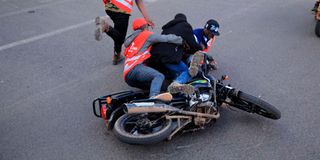
A motorbike rider involved in an accident on Ngong Road, Nairobi.
Hospitals in Molo and Naivasha are also reporting a steady rise in the number of boda boda crash victims.
The chaotic state of the sector is also evident in the number of motorcycles abandoned at police stations such as Nakuru Central.
Many are involved in accidents, have no documentation or are unclaimed because the owners died or were critically injured. The worrying statistics have prompted renewed calls for regulation and accountability.
The Senate Roads and Transportation Committee has proposed several amendments to the Public Transportation (Motorcycle Regulations) Bill, 2023 aimed at streamlining the sector and enhancing safety.
Under the proposed law, boda bodas will be required to display number plates on both the front and back, currently only mandatory for cars.
Motorcycles used for public transport will also be branded with designated colours to differentiate them from private bikes.
“The principal objective of this Bill is to put in place a legal framework to regulate the use of motorcycles (boda bodas) and three-wheelers (tuk-tuks) in Kenya, by introducing new provisions for their registration, operation, and safety at the county level,” reads the bill sponsored by Kakamega Senator Boni Khalwale.
Among other proposals, boda bodas will be treated as public service vehicles (PSVs) and subjected to regular inspections, registration and safety compliance checks.
A three-year grace period will be given to owners of older motorcycles to meet the new requirements, while new bikes must comply immediately.
The Bill also empowers county governments to create their own motorcycle-related legislation tailored to local needs while still aligning with national safety objectives.
The NTSA and the Ministry of Transport have been urged to amend the Traffic (Registration Plates) Rules to support these changes.
The growth of the boda boda sector was fueled in 2008 when Kenya zero-rated import duty on motorcycles in a bid to create jobs for its ballooning youth population. Registrations soared from 16,293 in 2007 to 51,412 in 2008.
As of today, about 2.5 million motorcycles are registered in Kenya, with 1.8 million actively in use.
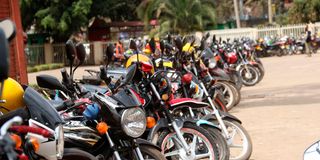
Motorbikes belonging to boda boda operators.
The sector has helped thousands of youth earn a living — many riders in Nairobi reportedly make between Sh2,000 and Sh3,000 per day. Those leasing motorcycles typically charge Sh400 per unit per day.
But this livelihood now carries an enormous risk. The death rate continues to rise, driven by rampant disregard for traffic rules, weak enforcement, and systemic corruption.
In response to the crisis, major hospitals have set up trauma centers to deal with the flood of accident victims, particularly from the boda boda sector. While regulations exist, they are often ignored.
Riders are required by law to have valid licenses, wear helmets and reflector jackets, ensure headlights are on at all times, and carry only one passenger. Motorcycle owners are also expected to ensure their bikes are roadworthy, insured, and equipped with two helmets and two reflector jackets.
In reality, many riders operate without training or documentation, and openly flout traffic laws. The sector now finds itself at a crossroads — between being a vital source of income and a growing public health crisis.



